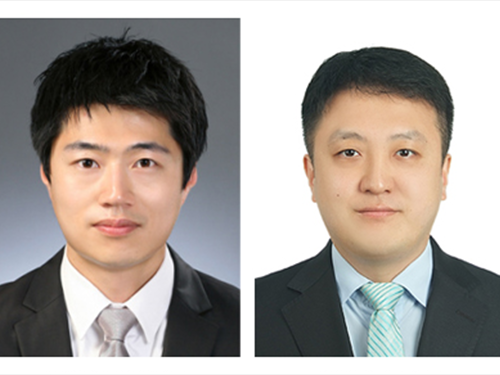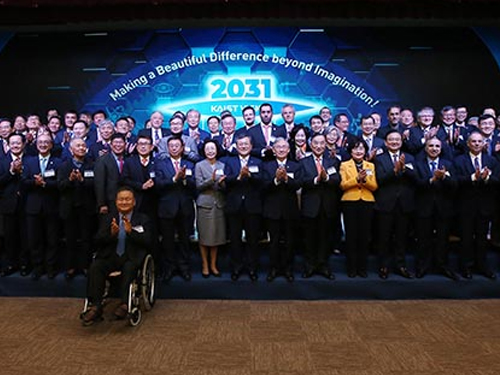Vision+Week
-
 KAISTians Receive Future Ocean Science and Technology Awards
(From left: PhD candidates Minseok Kang and Junkeon Ahn)
PhD candidates Minseok Kang and Junkeon Ahn from the Department of Mechanical Engineering received Future Ocean Science and Technology Awards from the Korean Association of Ocean Science and Technology Societies (KAOSTS).
Since 2017, KAOSTS has conferred this award upon graduate students who have published outstanding papers on ocean science and technology in order to encourage young researchers in this area.
Kang published ‘Ship block assembly sequence planning considering productivity and welding deformation’ in Naval Architecture and Ocean Engineering in which he proposed an assembly sequence planning method for block assemblies that considers the geometric characteristics of blocks to determine feasible assembly sequences as well as assembly process and productivity factors.
Ahn published ‘Fuzzy-based FMEA of hybrid MCFC and gas turbine system for marine propulsion’ in Power Sources. In this research, he conducted a study proposing a fuzzy-based failure mode and effect analysis (FMEA) for a hybrid molten carbonate fuel cell and gas turbine system for liquefied hydrogen tankers.
2018.06.15 View 7609
KAISTians Receive Future Ocean Science and Technology Awards
(From left: PhD candidates Minseok Kang and Junkeon Ahn)
PhD candidates Minseok Kang and Junkeon Ahn from the Department of Mechanical Engineering received Future Ocean Science and Technology Awards from the Korean Association of Ocean Science and Technology Societies (KAOSTS).
Since 2017, KAOSTS has conferred this award upon graduate students who have published outstanding papers on ocean science and technology in order to encourage young researchers in this area.
Kang published ‘Ship block assembly sequence planning considering productivity and welding deformation’ in Naval Architecture and Ocean Engineering in which he proposed an assembly sequence planning method for block assemblies that considers the geometric characteristics of blocks to determine feasible assembly sequences as well as assembly process and productivity factors.
Ahn published ‘Fuzzy-based FMEA of hybrid MCFC and gas turbine system for marine propulsion’ in Power Sources. In this research, he conducted a study proposing a fuzzy-based failure mode and effect analysis (FMEA) for a hybrid molten carbonate fuel cell and gas turbine system for liquefied hydrogen tankers.
2018.06.15 View 7609 -
 KAIST Unveils Vision 2031, a Blueprint for KAIST's Future
(Participants at the Vision 2031 Declaration Ceremony pose after the ceremony on March 20.)
KAIST presented a blueprint for KAIST’s future, “Vision 2031” looking toward its 60th anniversary. The strategic development plan for a “Global Value-Creative Leading University” aims at being one of the top universities in the world by the year 2031.
Unveiling its 2031 Vision, KAIST President Sung-Chul Shin presented the three-stage, five-year action plan during a ceremony held on March 20.
He stressed that innovation in the five pillars of education, research, technology commercialization, globalization, and future strategy will further advance the excellence of KAIST, to help it become a trailblazer in Korea and beyond.
President Shin said that Vision 2031 holds a special meaning, as the full support of the KAIST community was garnered to complete this shared vision for KAIST.
Approximately 140 members of the Vision Committee participated in the brainstorming process over the past ten months for reaching this vision. The committee went through consensus building procedures of public hearings engaging all of the stakeholders on campus as well as outside experts. The committee published “Vision 2031: KAIST’s Future Report” this month, detailing the action plan of innovation strategies for reaching its new vision as well as an expanded budget funding plan to secure 2 trillion KRW by 2031, up from the current 860 billion KRW.
First, in education, KAIST will foster creative leaders who will translate the knowledge created by science and technology into social values. In research, KAIST will conduct research projects to address both national and global challenges. KAIST will pursue becoming an entrepreneurial university that will enrich its technological value. In globalization innovation, KAIST will move forward to serve as a world bridge. Lastly, KAIST will steer toward the ‘What’ (problem definition) over the ‘How’ (problem solving) for addressing challenges in pursuing future strategy innovation.
The ceremony was held in Chung Kunmo Hall, in the newly opened the Academic Cultural Complex, with an attendance of more than 300 distinguished guests including global leaders in higher education, government, and industry, as well as from KAIST community.
Noted participants from abroad included KAIST President’s Advisory Council members such as Former President of ETH Zurich Rlaph Eichler, President of HKUST Tony Chan, President-elect Kazuya Masu of the Tokyo Institute of Technology, Former President of the National University of Singapore Tan Chorh Chuan, Nobel laureate Professor Kurt Wuthrich of the Scripps Research Institute, and Professor Klaus von Klitzing from the Max Planck Institute for Solid State Research. Former KAIST Presidents including Dr. Nam-Pyo Suh, Chairman of JoongAng Holdings Seok-hyun Hong, Elsevier Chairman Youngsuk Chi, KISWE Mobile Executive Chairman Jeong H. Kim also attended the ceremony.
In honor of the Vision 2031 declaration, KAIST is hosting 25 events during Vision Week from March 19 to 23 across the campus including academic forums, distinguished lectures, exhibits, and a coding challenge, among others. The opening of the Academic Cultural Center, an iconic building accommodating the new library, Cultural Building, and Vision Hall, launched Vision Week on Monday, March 19.
KAIST also dedicated Chung Kunmo Hall in the Academic Cultural Complex, a 300-seat capacity multi-purpose hall in honor of Professor Keun-Mo Chung, who played an instrumental role in founding KAIST in 1971.
Professor Chung submitted the proposal to US Aid to establish KAIST in 1969. US Aid asked the vice-president of Stanford University at the time, Frederick Terman, to conduct a feasibility study on the establishment of KAIST. The Terman Report, approving the founding of KAIST, was published in 1970 and KAIST was founded the next year. Following the dedication of Terman Hall in 2004, KAIST has now inducted its two founding figures.
“We had the guidebook of the Terman Report back then. We faithfully accomplished the initial mission and goals the Terman Report contained. At this critical juncture of the new global environment, we need to establish a new vision to continue to develop. As much as the Terman Report drove us to our current success, I hope the Vision 2031 KAIST Future Report will advance KAIST to its new chapter,” President Shin said.
Stressing that the ideal KAISTian is defined by the 3C spirit: Challenge, Creativity, and Caring, President Shin said, “Members of KAIST are expected to embrace challenges, generate creative ideas, and care for others. By recommitting to the five innovation strategies equipped with the KAIST spirit, KAIST will emerge as one of the top universities of science and technology by the year 2031 and contribute to the happiness and prosperity of humankind. I hope KAIST will be a great source of pride for Koreans and lay the foundation for Korea to take the lead in the age of the Fourth Industrial Revolution.”
2018.03.20 View 7322
KAIST Unveils Vision 2031, a Blueprint for KAIST's Future
(Participants at the Vision 2031 Declaration Ceremony pose after the ceremony on March 20.)
KAIST presented a blueprint for KAIST’s future, “Vision 2031” looking toward its 60th anniversary. The strategic development plan for a “Global Value-Creative Leading University” aims at being one of the top universities in the world by the year 2031.
Unveiling its 2031 Vision, KAIST President Sung-Chul Shin presented the three-stage, five-year action plan during a ceremony held on March 20.
He stressed that innovation in the five pillars of education, research, technology commercialization, globalization, and future strategy will further advance the excellence of KAIST, to help it become a trailblazer in Korea and beyond.
President Shin said that Vision 2031 holds a special meaning, as the full support of the KAIST community was garnered to complete this shared vision for KAIST.
Approximately 140 members of the Vision Committee participated in the brainstorming process over the past ten months for reaching this vision. The committee went through consensus building procedures of public hearings engaging all of the stakeholders on campus as well as outside experts. The committee published “Vision 2031: KAIST’s Future Report” this month, detailing the action plan of innovation strategies for reaching its new vision as well as an expanded budget funding plan to secure 2 trillion KRW by 2031, up from the current 860 billion KRW.
First, in education, KAIST will foster creative leaders who will translate the knowledge created by science and technology into social values. In research, KAIST will conduct research projects to address both national and global challenges. KAIST will pursue becoming an entrepreneurial university that will enrich its technological value. In globalization innovation, KAIST will move forward to serve as a world bridge. Lastly, KAIST will steer toward the ‘What’ (problem definition) over the ‘How’ (problem solving) for addressing challenges in pursuing future strategy innovation.
The ceremony was held in Chung Kunmo Hall, in the newly opened the Academic Cultural Complex, with an attendance of more than 300 distinguished guests including global leaders in higher education, government, and industry, as well as from KAIST community.
Noted participants from abroad included KAIST President’s Advisory Council members such as Former President of ETH Zurich Rlaph Eichler, President of HKUST Tony Chan, President-elect Kazuya Masu of the Tokyo Institute of Technology, Former President of the National University of Singapore Tan Chorh Chuan, Nobel laureate Professor Kurt Wuthrich of the Scripps Research Institute, and Professor Klaus von Klitzing from the Max Planck Institute for Solid State Research. Former KAIST Presidents including Dr. Nam-Pyo Suh, Chairman of JoongAng Holdings Seok-hyun Hong, Elsevier Chairman Youngsuk Chi, KISWE Mobile Executive Chairman Jeong H. Kim also attended the ceremony.
In honor of the Vision 2031 declaration, KAIST is hosting 25 events during Vision Week from March 19 to 23 across the campus including academic forums, distinguished lectures, exhibits, and a coding challenge, among others. The opening of the Academic Cultural Center, an iconic building accommodating the new library, Cultural Building, and Vision Hall, launched Vision Week on Monday, March 19.
KAIST also dedicated Chung Kunmo Hall in the Academic Cultural Complex, a 300-seat capacity multi-purpose hall in honor of Professor Keun-Mo Chung, who played an instrumental role in founding KAIST in 1971.
Professor Chung submitted the proposal to US Aid to establish KAIST in 1969. US Aid asked the vice-president of Stanford University at the time, Frederick Terman, to conduct a feasibility study on the establishment of KAIST. The Terman Report, approving the founding of KAIST, was published in 1970 and KAIST was founded the next year. Following the dedication of Terman Hall in 2004, KAIST has now inducted its two founding figures.
“We had the guidebook of the Terman Report back then. We faithfully accomplished the initial mission and goals the Terman Report contained. At this critical juncture of the new global environment, we need to establish a new vision to continue to develop. As much as the Terman Report drove us to our current success, I hope the Vision 2031 KAIST Future Report will advance KAIST to its new chapter,” President Shin said.
Stressing that the ideal KAISTian is defined by the 3C spirit: Challenge, Creativity, and Caring, President Shin said, “Members of KAIST are expected to embrace challenges, generate creative ideas, and care for others. By recommitting to the five innovation strategies equipped with the KAIST spirit, KAIST will emerge as one of the top universities of science and technology by the year 2031 and contribute to the happiness and prosperity of humankind. I hope KAIST will be a great source of pride for Koreans and lay the foundation for Korea to take the lead in the age of the Fourth Industrial Revolution.”
2018.03.20 View 7322